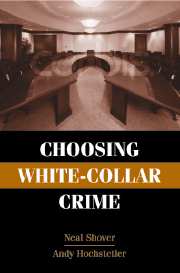5 - Decision Making
Published online by Cambridge University Press: 05 June 2012
Summary
Rational-choice theory is best seen as a “framework, a rubric or a family of theories” that serves to “organize findings, link theoretical statements and logically guide theory construction” (Hechter and Kanazawa, 1997:194). It has been applied to a host of problems and processes, including managerial decisions, interpersonal exchange, consumer purchasing, and the dynamics of economic markets. Arguably, it is the dominant theoretical paradigm in political science (Green and Shapiro, 1994; Hechter and Kanazawa, 1997; Smith, 1991). The importance of rational-choice theory as an interpretation of crime and as justification for contemporary initiatives in crime control is on firm footing.
Decision making is the heart of rational-choice theory. It is seen as a process of cognition and calculation in which actors pursue desired goals, weigh likely consequences, and select among options. This means that the structural conditions and generative worlds that lie “behind” readiness to choose crime are important primarily because they shape offenders' evaluation of potential costs and benefits. Normative confusion and ambiguity, for example, is a background variable that has been linked theoretically to increased likelihood of misconduct by organizational employees and managers (Passas, 1990; Reichman, 1993). When this theoretical relationship is cast in the logic of rational choice, rule ambiguity is significant principally for the ways it affects calculation and decision making by discrete actors. In addition to its potential payoffs for explaining and predicting variation in crime, enhanced understanding of decision making holds promise of guiding policy interventions to minimize criminal choices.
- Type
- Chapter
- Information
- Choosing White-Collar Crime , pp. 109 - 129Publisher: Cambridge University PressPrint publication year: 2005



